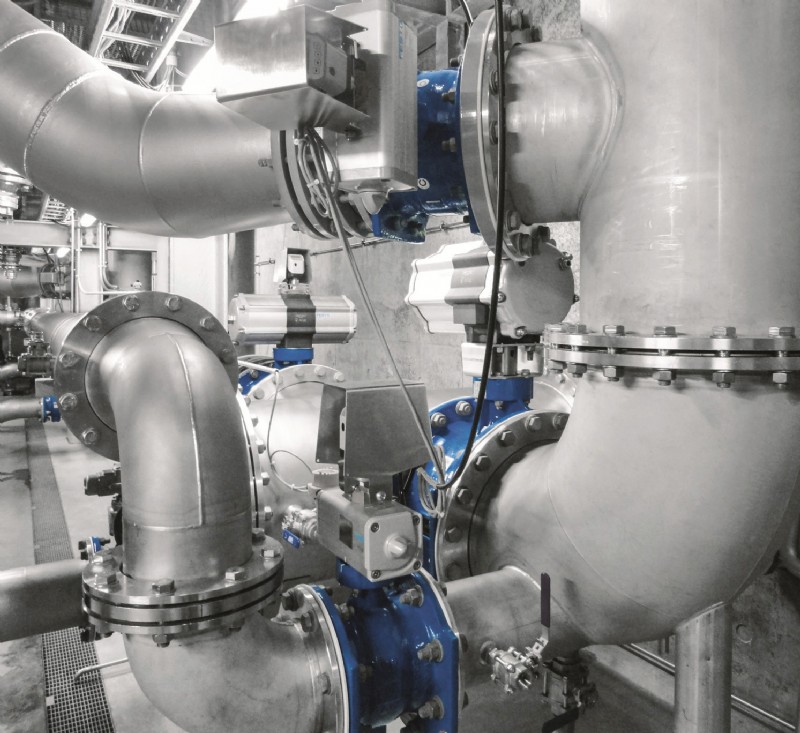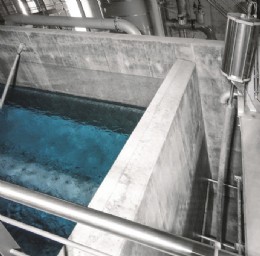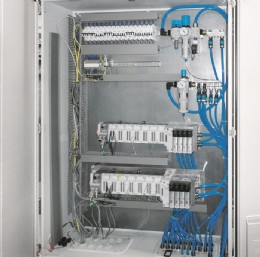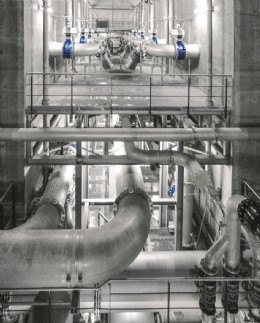10% Savings: Water Supply Company Makes Use of Pneumatics

Pneumatic actuators have a clear advantage compared to electric actuators in cramped installation spaces

Sludge water valves control pneumatic linear actuators DFPI with integrated displacement encoder; integration protects the encoder from harsh environmental influences, enhances running performance and reduces maintenance costs

Complete pneumatic automation solution from a single source: control cabinets supplied ready to install with project support, conceptualisation and implementation

Impressive technology in the three-level pipe cellar: 70 pneumatically actuated shut-off valves open and close the pipelines during backwashing of the multi-media filters in the Langenau water treatment plant
“Our aim is to be the best value longdistance water supply company in Germany, offering the best quality drinking water while ensuring a reliable supply and sustainable use of resources.” That is the guiding principle of Landeswasserversorgung, based in Stuttgart/Germany. By providing a pneumatic automation solution encompassing project support, conceptualisation and implementation, Festo has played a part in achieving this.
Landeswasserversorgung provides 90 million cubic metres of drinking water every year to around 250 towns, cities and communities in Baden-Württemberg and Bavaria. The long-distance water supply company thus supplies water to around three million people. The Langenau plant is one of the largest and most state-of-theart water treatment plants in Europe.
Controlling the water flow
The automation controls the water flow using pneumatic valve actuators and process valves for regulation and shut-off as well as for preventing return flow. The water supply company installed seven open two-tier filters in the new ground water filtration system at the Langenau water treatment plant. Here, the water flows first through a multi-media filter and then through an activated carbon filter. After a certain amount of time, the filters need to be backwashed.
During backwashing of one multi-media filter, the pipelines are opened and closed by 10 shut-off valves. These valves are actuated by pneumatic quarter turn actuators DAPS. They have an adjustable swivel angle, are compact and have torque characteristics that are suitable for process valves. The torque is generated via a scotch yoke mechanism which helps to overcome the valve’s high breakaway torques.
Complete pneumatic control circuit
The actuators are controlled by valve terminals CPX-VTSA with Profinet connection. The valve terminals pick up all the signals from the filters, including feedback from actuators, pressure, temperature or fill level. The valve terminals CPX-VTSA are protected from harsh environments thanks to the sturdy metal housing, completely sealed valves and ducted exhaust air and pilot air. The highly modular valve terminal with five options for valve sizes saves energy because the required flow for each valve position can be precisely set.
In addition, a pneumatic linear actuator DFPI regulates the laterally mounted sludge water valves. A crucial feature of the DFPI is the integration of the displacement encoder in the actuator, which protects it from harsh environmental influences, enhances running performance and reduces maintenance costs. The pneumatic automation solution was rounded off with ready-to-install control cabinets and with all the accessories needed for the pneumatic control circuits, such as air preparation, tubing and fittings. Overall, the solution saved Landeswasserversorgung 10% on their investment and operating costs compared to electric automation.
Benefits of pneumatics
The water supply company benefited from the many advantages of pneumatics in process automation. Pneumatic components are resistant to continuous loads and maintenance-free over their entire service life. They are very easy to install and are cheaper than comparable electrical solutions, particularly when implementing complete system solutions. Pneumatic components are also very impressive when it comes to safety. Compressed air continues to be available even during a power failure. An air reservoir is always available along with a compressor for generation and preparation purposes.
Pneumatics is an uncomplicated technology which is easy to install. Apart from end-position sensing and monitoring the compressed air supply, it doesn’t need to be monitored and checked. It follows the ‘fit and forget’ principle.
Durable technology
Pneumatic actuators have proven to be shock-proof and durable since, in contrast to electric actuators, they are made up of a small number of components and are thus less likely to break down. Pneumatic actuators are also resistant to continuous loads and remain maintenance-free over their entire service life. There is no need for oil changes or additional lubrication.
The low costs mean that it is even worthwhile automating manual process valves at a later date. Specifically, when compared to electric drive technology, the consistent use of decentralised automation concepts with valve terminals provides significant cost benefits – in the case of the Langenau water treatment plant, this meant savings of 10%. Some projects have even seen savings of more than 50%.
Smaller sizes are possible
Pneumatic actuators only require electricity for the control and generation of compressed air; the movement itself is triggered by the compressed air. Whereas electric actuators require gearboxes, which are responsible for most of the power losses as well as electrical heat losses, pneumatic actuators act directly on the shut-off device. They only require a piston and drive shaft to convert the ‘linear’ compressed air force into a swivel motion.
Since pneumatic actuators are overloadproof and a higher actuation force can be achieved very simply by increasing the pressure, it is often possible to use smaller sizes with a lower weight than would be the case for electric actuators. Provided the tubing has zero leakage and the units are precisely dimensioned, the resulting solutions are energy-efficient. Pneumatic systems from Festo can deliver high forces of up to 50,000 N and torques of up to 10,000 Nm. Small sizes were also advantageous for the Langenau water treatment plant. On account of their size alone, electric actuators would hardly have stood a chance in the cramped surroundings of the pipe cellar.
Expert advice
Experts from Festo are available to help in the calculation of the compressed air consumption and the optimum layout of the compressed air network, and can also provide support during the tendering stage on request. Customers receive everything from a single source, and with just one part number – making the order handling process simple and ensuring rapid implementation of the project.
Tel: +44(0)800 626422
Email: info_gb@festo.com
Web: www.festo.com

| Telephone: | 0800 626422 |
| Email: | info.gb@festo.com |
| Website: | www.festo.com |
| More information on the Festo Ltd BVAA Member Directory Page |
Search related valve / actuator articles: Festo LtdIssue 41ActuatorsPneumatic Actuators







-web.jpg)





